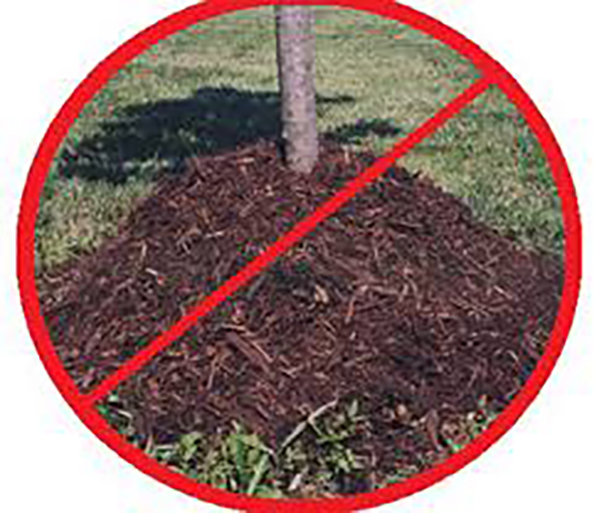 Mulching your landscape has many benefits for your garden, but the reason most homeowners mulch is to give their property a dramatic finished look. Your plants and flowers pop out with mulch.
Mulching your landscape has many benefits for your garden, but the reason most homeowners mulch is to give their property a dramatic finished look. Your plants and flowers pop out with mulch.
Properly used mulch suppresses weeds, keeps the soil moist, and maintains the soil temperature. This will help keep your plants healthy and reduce maintenance, especially weeding during the summer months.
Usually one or two inches of mulch with 5 inches of space between the base of trees and/or the stems of shrubs is a good rule of thumb.
Mulching trees and shrubs is a recommended cultural maintenance method with many benefits, yet it can literally kill plants if mulch is applied improperly.
VOLCANO MULCHING KILLS TREES AND SHRUBS
A mountain of mulch, piled high against the tree trunk, does not kill a tree immediately but will result in a slow death. Over-mulching is a waste of mulch (and money!). It is a leading cause of death for azalea, rhododendron, dogwood, boxwood, mountain laurel, hollies, cherry trees, ash, birch, linden, spruce, and many other landscape plants.
How does over-mulching kill trees and shrubs?
- Lack of oxygen to tree roots. This is especially common in the spring and the fall, which are critical periods for root growth, and during other wet periods. Symptoms may take several years to appear.
- Inner bark death.This comes from the piles of mulch placed directly against the stems/trunks of trees and shrubs. (This can also happen to trees planted too deeply. Carefully follow directions when planting trees and bushes.)
- Fungal and bacterial diseases.Moisture is required to spread and reproduce these diseases. Trunk diseases gain a foothold into the moist, decaying bark tissue under the mulch. Once established, the disease organisms ultimately invade the inner bark, starving the plant, and finally kill the plant.
- Excess heat.This is created when wet mulch starts to heat up and begins to decompose the lower bark.
- Rodents such as mice and voles.These live under the warm mulch in the winter and chew on the nutritious inner bark. Often this goes unnoticed until the following spring when the “tree doesn’t look good”.
Information in this article is from Rutgers Cooperative Extension Fact Sheet FS099 Deborah Smith-Fiola, Agricultural Agent, Ocean County
Happy Gardening, James
